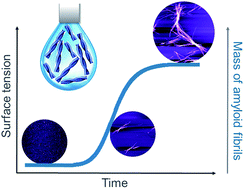Monitoring the surface tension by the pendant drop technique for detection of insulin fibrillogenesis
Abstract
Monitoring the aggregation of amyloid-prone proteins is critical for understanding the mechanism of amyloid fibril formation. Insulin, when dissolved in low pH buffer, has a surface tension of 61–64 mN m−1, as measured by the pendant drop technique. Formation of insulin amyloid fibrils resulted in the increase of the surface tension values up to 71.2–73.5 mN m−1. The kinetics of fibril formation and fibril morphology were validated by ThT fluorescence and AFM, respectively. The results demonstrate that monitoring the surface tension by the pendant drop technique is a valuable tool for the detection of insulin amyloid aggregation.



 Please wait while we load your content...
Please wait while we load your content...